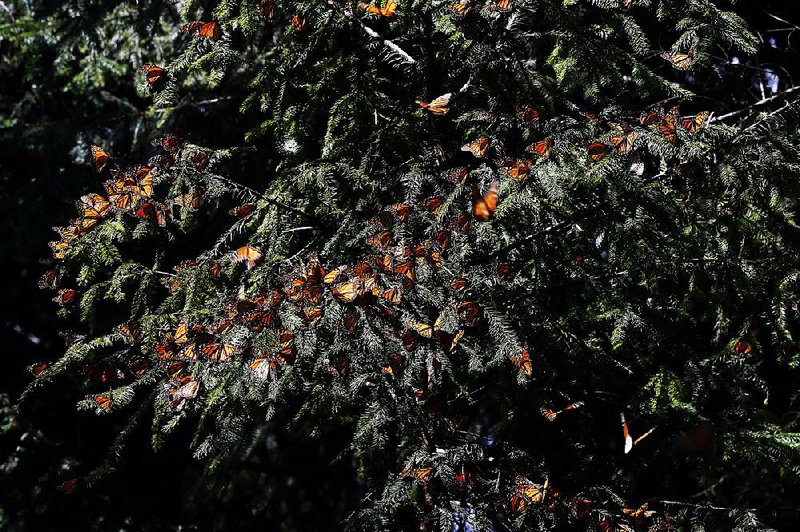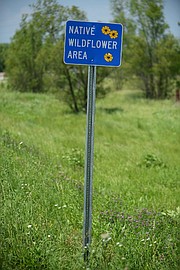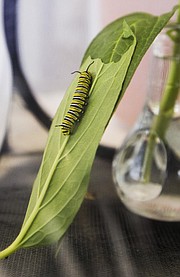MaryAnn King has seen only eight or 10 monarch butterflies this spring.
That's down about 80% from the 1990s, said King, whose family operates Pine Ridge Gardens, a small nursery near London in Pope County.
"I can remember in the early '90s, during migration, you couldn't hardly drive a car without hitting them there would be so many flying," she said. "Now, you're lucky to see monarchs."
Part of the problem, King said, is the Arkansas Department of Transportation has been mowing the milkweed along highways. Monarchs lay their eggs on milkweed. It's all their caterpillars will eat.
"I have asked them to please stop mowing the milkweeds," King said. "There are too many old white men making the rules. They like to see nicely mowed roadsides."
Kayti Ewing, a botanist with the Transportation Department, said the department has been working to attract monarch butterflies and other pollinators.
"We altered our mowing routine so we're not mowing full width all the time," she said.
When an interstate highway goes through a city, though, the city can dictate how the area along the interstate is mowed, Ewing said. There are three cities -- Little Rock, West Memphis and Russellville -- that mow along some interstates where the Transportation Department would let the grass grow, she said.
Russellville mows a section of Interstate 40 where milkweed grows, Ewing said. Russellville is 8 miles east of London.
"It happens on such a small percentage of our roadways," she said. "I feel like we're providing enough pollinator habitat elsewhere."
The state Transportation Department is also planting native wildflowers to attract butterflies and other pollinators that feed on the nectar. Ewing said milkweed seeds are included in the mix when the roads travel through federal lands. But it would be too expensive for the Transportation Department to include milkweed seeds with the wildflower mix along all Arkansas highways, she said.
A poster explaining the department's efforts is titled "Collaborative Implementation of Integrated Roadside Vegetation Management Practices: Maintenance Mows for Monarchs!"
There are three zones next to state highways: a clear zone (10-30 feet wide) that is mowed three times a year. Next to the clear zone is a transition zone (10-50 feet wide) that is mowed once a year in the fall. Then there is a natural zone that extends to the right of way fence and often has trees, according to the Transportation Department poster.
Ewing said the department came up with the new mowing plan in 2003 but didn't implement it until 2016.
She said people call occasionally saying the highway department needs to come out and mow the grass.
"It provides an aesthetically pleasing roadside and place for pollinators," she tells them. "That's something I think we're still trying to sell to the public."
Ewing said Arkansas' attention on the monarchs began a few years ago along with a national push to save the butterflies.
In 2014, the U.S. Department of the Interior was petitioned to list the monarch butterfly as endangered. Its final decision is due next month.
Also in 2014, President Barack Obama issued a memorandum to "promote the health of honey bees and other pollinators."
"The number of migrating monarch butterflies sank to the lowest recorded population level in 2013-14, and there is an imminent risk of failed migration," according to the memorandum.
The estimated number of monarch butterflies has increased since then, based on observations where they winter in the mountains of central Mexico. But the number estimated in December was still down about 67% from 1996.
The population of monarch butterflies wintering in central Mexico was up 144 percent last December when compared with December 2017, according to Journeynorth.org, citing data from the World Wildlife Fund-Mexico and the Monarch Butterfly Biosphere Reserve.
Researchers found the butterflies occupying 14.94 acres of pine and fir forests in the mountains of Michoacan and Mexico states. That's an increase from 6.12 acres a year ago.
It was the biggest measurement since 2006, but last winter's number was down considerably from December 1996, when the butterflies covered 44.93 acres of the Mexican forest.
The monarch is unique among butterflies.
"The monarch is the only butterfly known to make a two-way migration as birds do," according to the U.S. Forest Service. "Unlike other butterflies that can overwinter as larvae, pupae or even as adults in some species, monarchs cannot survive the cold winters of northern climates. Using environmental cues, the monarchs know when it is time to travel south for the winter. Monarchs use a combination of air currents and thermals to travel long distances. Some fly as far as 3,000 miles to reach their winter home."
Since more monarch butterflies roosted in the mountains of Mexico last winter, Arkansas should see more monarchs this year, experts say.
With a wingspan of at least 3.7 inches, the bright orange, black and white butterflies have a large fan club.
Monarch butterflies are "just a very charismatic insect," said Hanna L. Ford, a Ph.D. candidate at the University of Arkansas, Fayetteville.
"People are obsessed with this butterfly," she said. "I think it's because they're such a beautiful species."
Monarch butterflies pass through Arkansas twice a year, in the spring on their way from Mexico to Canada, and in the fall on the way back to Mexico. Some monarchs stay in Arkansas throughout the summer.
Having flown more than 1,000 miles from Mexico, they begin arriving in Arkansas in March with torn and faded wings, said Allison Fowler, wildlife diversity program coordinator for the Arkansas Game and Fish Commission.
Some of the monarchs lay eggs on milkweed plants in Arkansas and die shortly afterward, she said. The eggs hatch, and caterpillars transform into fresh butterflies. The whole process takes about a month.
Most of the monarchs in Arkansas head north by summer.
"We're part of their original species range," Fowler said. "In Arkansas, they migrate through, but they also stay and breed, so it's a little bit of a mix. ... Our population is low in summer because the majority will continue north into southern Canada."
Right now, monarchs can be found all over the state, she said.
"Any place that has prairie habitat is probably going to be a decent place to see them," she said. "We don't really have a population estimate at this point."
In the fall of 2017, the Arkansas Monarch Mapping Project began to try to keep track of the butterfly sightings in the Natural State. The website is inaturalist.org/projects/arkansas-monarch-mapping-project.
Since the website went online, 125 people have signed on to participate in the project, and there had been 627 observations of monarchs in Arkansas as of Friday.
Most of the observations (126) were made by the Arkansas Monarch Conservation Partnership, which published the Arkansas Monarch and Pollinator Conservation Plan in May 2018. The group's website is arkansasmonarchs.org.
Fowler said the Game and Fish Commission would like for people to log their monarch observations onto the website or one of the national websites, such as Journeynorth.org.
Leslie Fowler, no relation to Allison Fowler, is Arkansas' monarch and pollinator coordinator.
She said there are three distinct populations of monarch butterflies: a western population, which winters in California; the eastern population, which passes over much of middle America east of the Rocky Mountains on the way to Canada; and a nonmigratory population that stays in Florida.
State Desk on 05/26/2019



